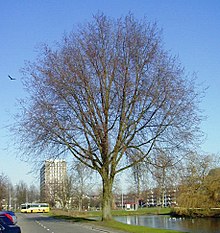Ulmus × hollandica 'Vegeta'
| Ulmus × hollandica cultivar | |
|---|---|

'Vegeta', Groningen.
|
|
| Hybrid parentage | U. glabra × U. minor |
| Cultivar | 'Vegeta' |
| Origin | England |
Ulmus × hollandica 'Vegeta', sometimes known as the Huntingdon Elm, is an old English hybrid cultivar raised at Brampton, near Huntingdon, by nurserymen Wood & Ingram in 1746, allegedly from seed collected from an Ulmus × hollandica hybrid at nearby Hinchingbrooke Park. The tree was given the epithet 'Vegeta' by Loudon, a name previously accorded the Chichester Elm by Donn, as Loudon considered the two trees identical. The latter is indeed a similar cultivar, but raised much earlier in the 18th century from a tree growing at Chichester Hall, Rawreth in Essex.
In areas unaffected by Dutch elm disease, Huntingdon Elms commonly grow to over 35 m, bearing long, straight branches ascending from a short bole < 4 m in height; the bole of mature trees has distinctive lattice-patterned bark-ridges which serve to distinguish the tree from another popular U. × hollandica cultivar 'Major', known as 'Dutch Elm', whose bark breaks into small shallow flakes. The glossy, oval leaves have petioles >10 mm long, which serve to distinguish the tree from the Wych Elm, and are very distinctly asymmetric at the base, < 12 cm long by < 7.5 cm broad contracting to an acuminate apex. The leaves are borne on smooth branchlets that never feature corky wings. The tightly-clustered apetalous flowers are bright red, and appear in early spring. The samarae are obovate, < 25 mm long.
...
Wikipedia
